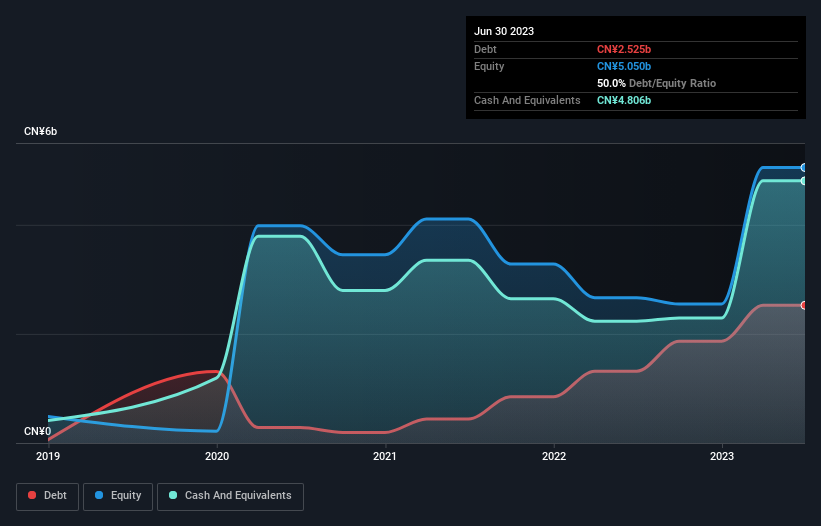
David Iben put it well when he said, 'Volatility is not a risk we care about. What we care about is avoiding the permanent loss of capital.' So it seems the smart money knows that debt - which is usually involved in bankruptcies - is a very important factor, when you assess how risky a company is. As with many other companies Akeso, Inc. (HKG:9926) makes use of debt. But is this debt a concern to shareholders?
When Is Debt Dangerous?
Generally speaking, debt only becomes a real problem when a company can't easily pay it off, either by raising capital or with its own cash flow. Ultimately, if the company can't fulfill its legal obligations to repay debt, shareholders could walk away with nothing. However, a more frequent (but still costly) occurrence is where a company must issue shares at bargain-basement prices, permanently diluting shareholders, just to shore up its balance sheet. Of course, plenty of companies use debt to fund growth, without any negative consequences. When we think about a company's use of debt, we first look at cash and debt together.
See our latest analysis for Akeso
What Is Akeso's Net Debt?
As you can see below, at the end of June 2023, Akeso had CN¥2.52b of debt, up from CN¥1.32b a year ago. Click the image for more detail. However, it does have CN¥4.81b in cash offsetting this, leading to net cash of CN¥2.28b.

How Healthy Is Akeso's Balance Sheet?
The latest balance sheet data shows that Akeso had liabilities of CN¥933.3m due within a year, and liabilities of CN¥3.03b falling due after that. On the other hand, it had cash of CN¥4.81b and CN¥288.9m worth of receivables due within a year. So it actually has CN¥1.13b more liquid assets than total liabilities.
This surplus suggests that Akeso has a conservative balance sheet, and could probably eliminate its debt without much difficulty. Simply put, the fact that Akeso has more cash than debt is arguably a good indication that it can manage its debt safely.
It was also good to see that despite losing money on the EBIT line last year, Akeso turned things around in the last 12 months, delivering and EBIT of CN¥1.5b. There's no doubt that we learn most about debt from the balance sheet. But ultimately the future profitability of the business will decide if Akeso can strengthen its balance sheet over time. So if you're focused on the future you can check out this free report showing analyst profit forecasts.
Finally, a company can only pay off debt with cold hard cash, not accounting profits. While Akeso has net cash on its balance sheet, it's still worth taking a look at its ability to convert earnings before interest and tax (EBIT) to free cash flow, to help us understand how quickly it is building (or eroding) that cash balance. During the last year, Akeso generated free cash flow amounting to a very robust 87% of its EBIT, more than we'd expect. That puts it in a very strong position to pay down debt.
Summing Up
While it is always sensible to investigate a company's debt, in this case Akeso has CN¥2.28b in net cash and a decent-looking balance sheet. The cherry on top was that in converted 87% of that EBIT to free cash flow, bringing in CN¥1.3b. So is Akeso's debt a risk? It doesn't seem so to us. When analysing debt levels, the balance sheet is the obvious place to start. However, not all investment risk resides within the balance sheet - far from it. For example - Akeso has 2 warning signs we think you should be aware of.
At the end of the day, it's often better to focus on companies that are free from net debt. You can access our special list of such companies (all with a track record of profit growth). It's free.
New: Manage All Your Stock Portfolios in One Place
We've created the ultimate portfolio companion for stock investors, and it's free.
• Connect an unlimited number of Portfolios and see your total in one currency
• Be alerted to new Warning Signs or Risks via email or mobile
• Track the Fair Value of your stocks
Have feedback on this article? Concerned about the content? Get in touch with us directly. Alternatively, email editorial-team (at) simplywallst.com.
This article by Simply Wall St is general in nature. We provide commentary based on historical data and analyst forecasts only using an unbiased methodology and our articles are not intended to be financial advice. It does not constitute a recommendation to buy or sell any stock, and does not take account of your objectives, or your financial situation. We aim to bring you long-term focused analysis driven by fundamental data. Note that our analysis may not factor in the latest price-sensitive company announcements or qualitative material. Simply Wall St has no position in any stocks mentioned.
About SEHK:9926
Akeso
A biopharmaceutical company, researches, develops, manufactures, and commercializes antibody drugs.
Exceptional growth potential with adequate balance sheet.


